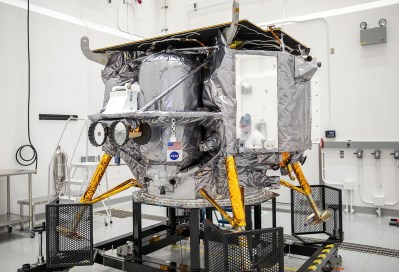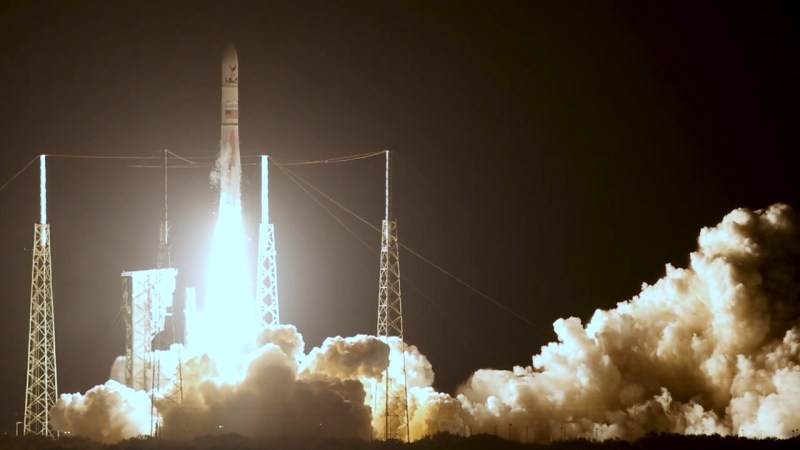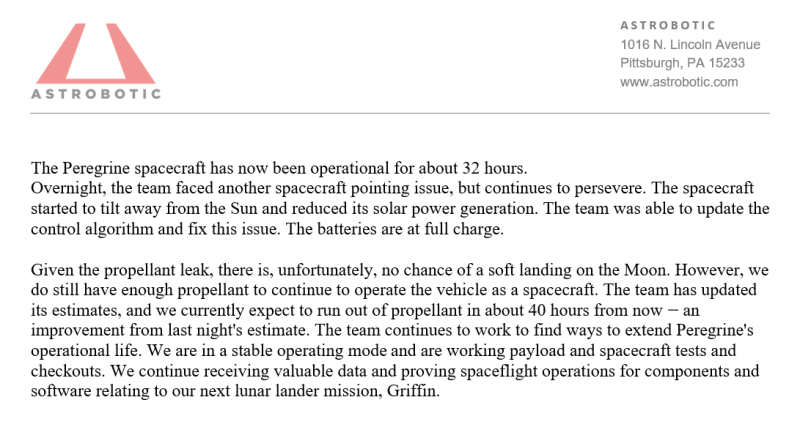For those with an interest in the history of spaceflight, January 8th promised to be a pretty exciting day. Those who tuned into the early morning live stream were looking forward to seeing the first flight of the Vulcan Centaur, a completely new heavy-lift booster developed by United Launch Alliance. But as noteworthy as the inaugural mission of a rocket might be under normal circumstances, this one was particularly special as it was carrying Peregrine — set to be the first American spacecraft to set down on the lunar surface since the end of the Apollo program in 1972.
Experience has taught us that spaceflight is hard, and first attempts at it doubly so. The likelihood of both vehicles performing as expected and accomplishing all of their mission goals was fairly remote to begin with, but you’ve got to start somewhere. Even in the event of a complete failure, valuable data is collected and real-world experience is gained.
Now, more than 24 hours later, we’re starting to get that data back and finding out what did and didn’t work. There’s been some disappointment for sure, but when everything is said and done, the needle definitely moved in the right direction.
Vulcan: Better Late than Never
Since their formation in 2006, United Launch Alliance (ULA) has maintained a 100% mission success rate between their primary rockets, the Atlas V and Delta IV. While there were always cheaper rides to space, notably on Russia’s Soyuz rocket, ULA became known as the launch provider you selected if you absolutely had to get your payload into space.
But by the early 2010s, it was clear the commercial launch market was changing. Not only was it far cheaper to fly on the Falcon 9, but SpaceX was launching them at (when compared to the entrenched players) a startling rate. While their legacy rockets still had the edge in reliability, guaranteeing ULA certain high-profile payloads, it was clear they needed to develop a cheaper and more agile rocket to remain competitive.
In addition, the continued use of the Russian RD-180 rocket engines that powered the Atlas V were becoming a political liability. So in 2014, the decision was made to take all the knowledge and experience gained while operating the Atlas and Delta and combine that into a new booster: Vulcan Centaur.
It was hoped that the rocket, a combination of the all-new Vulcan first stage and an evolved version of ULA’s Centaur III second stage, could be flying as soon as 2019. But the program suffered several delays due to the slower than expected development of its BE-4 engines by Jeff Bezos’ Blue Origin. Plans to make the system partially reusable, similar to SpaceX’s Falcon 9, were also delayed indefinitely in order to get the program operational sooner.
While an explosion during the testing of the Centaur upper stage in March of 2023 did push the date of the rocket’s inaugural flight out to 2024, the January 8th launch apparently went off without a hitch — an even more impressive feat when you consider that the BE-4 engines are powered by liquid methane and liquid oxygen, a combination colloquially known as methalox, which had never successfully been used by an American orbital rocket previously. Other methalox vehicles from the US, such as SpaceX’s Starship or the Relativity Space Terran 1, have flown but have failed to achieve orbit.
In a post to social media, CEO of United Launch Alliance Tory Bruno said that Monday’s launch was among the smoothest he’d ever seen in his career. While obviously not the most unbiased source in this case, it’s clear that it was a day worth celebrating at ULA.
Peregrine: A Dramatic Stumble
While the first flight of the Vulcan Centaur looks to have been the picture of success, Peregrine’s inauspicious start was arguably the polar opposite. Just hours after the lander separated from the Centaur upper stage, it was clear something had gone terribly wrong, and that its historic return to the Moon was likely out of reach.
 Astrobotic Technology announced the development of the Peregrine lander in 2016, and by 2019, it had been awarded a $108 million contract under NASA’s Commercial Lunar Payload Services (CLPS) initiative, an ancillary component of the larger Artemis program. The 1,283 kg (2,829 lb) vehicle was designed to ultimately bring 265 kg (584 lb) of payload to the lunar surface, but on this first mission the craft was limited to only 90 kg (200 lb).
Astrobotic Technology announced the development of the Peregrine lander in 2016, and by 2019, it had been awarded a $108 million contract under NASA’s Commercial Lunar Payload Services (CLPS) initiative, an ancillary component of the larger Artemis program. The 1,283 kg (2,829 lb) vehicle was designed to ultimately bring 265 kg (584 lb) of payload to the lunar surface, but on this first mission the craft was limited to only 90 kg (200 lb).
Among the cargo being brought to the Moon, Peregrine was carrying more than a dozen memorials and time capsules, eight scientific instruments, the Iris rover from Carnegie Mellon University, and five small autonomous robots built by the Mexican Space Agency.
According to Astrobotic, it seemed the mission was off to a solid start when Peregrine first separated from the booster. Teams on the ground established communications with the rover, and critical systems started to come online as expected. But shortly after enabling its propulsion systems, the craft seemed unable to maintain the necessary attitude to keep its solar panels pointed to the sun. This in turn lead to the vehicle’s batteries being drained to a dangerously low level within just a few hours.
Approximately ten hours after launch, Astrobotic posted an update to social media announcing that they had stabilized the craft and that its batteries were now charging. Unfortunately, while the immediate situation had improved, the concern on the ground was that the craft’s propulsion system had suffered some sort of failure. In a subsequent post, they confirmed the worst case scenario: that a leak was not only destabilizing the craft, but bleeding it of the propellants it needed to make a landing on the Moon.
As of the last update from Astrobotic, a landing had been completely ruled out. Further, between the leak and the constant maneuvering thruster firings necessary to keep the craft properly oriented, the team estimates the tanks will be dry within 40 hours. Before then ground controllers will attempt to set it on a trajectory that will take it as close as possible to the Moon, but without the ability to orient itself, there’s no guarantee on how long communications with the craft will hold out.
Space is Still Hard
All told, January 8th will certainly be looked back on as a major day for spaceflight. America put its first methalox rocket into orbit, and just hours later, had its lunar landing aspirations dashed. Although modern technology has greatly improved our overall access to space, its days like this that remind us of how easily things can go sideways.
But that doesn’t mean we’ll stop trying. The Moon is still calling, and we won’t have to wait long until another mission is on its way to our nearest celestial neighbor. The Nova-C lander, built by Intuitive Machines and also funded by NASA’s CLPS program, is due to liftoff in February. No matter what happens, we’re eager to see it unfold.



















To bad. Stuff happens. Hopefully they will learn from the failure, and try again. As said above ‘space is hard’ which is good as it ‘challenges’ us to overcome the difficulties and move tech forward.
What makes me wonder though, how did the guys in the 1960s got things to work under much worse conditions?
They not only had much higher time pressure (tighter schedule), but also had to do the math on paper. The computers (machines) of the time were not as flexible as they’re now. Simulators of the day were more limited, too.
Yet still, they didn’t need decades “to make their homework”. Or let’s just look at the Chinese space program. It started from zero 20 years ago (with a bit of help of Russian construction plans, I assume).
The upshot is that lots of documents from NASA are open/public domain. So any US company can study construction plans. The non-confidential parts, at least. The rest is being described (conceptual, at least) in various technical books.
Yes, space might be hard. Especially if you want to ride on a cigar. But we’re talking about decades by now. What did these companies and federal agencies do all those years? What happened to the knowledge they had in the 1960s? The Russians never had trouble of that kind. They’ve just kept optimizing their Sojus/Progress ships a little bit over the years. Has the US learning issues, maybe? I don’t know, I don’t have any insights. I’m just a foreigner here. 🤷♂️
They had more money for tests and engineers double checking that it will indeed work. Nowadays it’s two lonely engineers checking some parts on computer, while neglecting others and missing that one small hose might fall off druing a little too violent shaking. Completely different from making sure everything works, up to changing atmosphere to pure oxygen.
I understand, but why do the people in charge believe that this approach will lead to success? One quote in the article said “it felt like the 90th mission, not the first flight”.
I’m not sure what to make of it and if that’s good or bad. I mean, failures are surely part of research and development. It’s just the very long time frame. We’re close to 2025. I repeat, 2025! All of this should have been done in the ’80s already. The shuttle was meant to leave earth orbit, yet it never got a chance to do so.
In 2025, earth orbit is full of satellites, yet the last moon landing was 50 years ago. And the technology and simulation software in particular of today is incredible powerful.
But maybe that’s the problem here? Over-Engineering? Too much sunshine technology (electronics) that can fail?
The Russian used much simpler technology, sometimes even mechanical solutions. Yet their vehicles seem to have a lower failure rather?🤷♂️
The “felt like the 90th mission” quote is from ULA, who absolutely nailed their first flight, because they do it the old fashioned way by testing and engineering the crap out of everything, instead of slapping things together and assuming the first 10 launches will blow up.
The latter method was pioneered by SpaceX who accidentally got away with it when their make-or-break launch finally succeeded. Now most space startups seem to assume that this stroke of luck will happen to them as well, of course it’s dangerous to bet the house on that. You lose some, you may win some and hopefully before the money runs out.
Mind you I’m not saying the Astrobotic team thinks like that, space is hard and they might just have had bad luck. But I’m convinced that most space failures lately have been due to a startup yuppie mentality of “throw it in space and cross your fingers”. Most space failures lately have been due to software errors and I firmly believe an over-reliance on software is to blame for many of the failures. I’ve personally witnessed projects go from “let’s do everything on deterministic controllers” to “we can’t do it unless we use full-blown Linux” in just a few months, and all it took was hiring some CS majors, who seem to like to bring the horrible state of software down into the embedded and space fields that used to be known for their reliability.
Small code size guarantees an upper bound on the number of possible states a system can have, and you increase your chances of understanding and testing most of them before launch. From the moment you start throwing huge amounts of code (whether internally developed or external) at the problem, your chances of ever understanding the system’s behavior in all cases go to zero quickly. Even if you have access to the source. It just becomes too much for a human brain to comprehend all possible states and interactions.
“The Russian used much simpler technology, sometimes even mechanical solutions. Yet their vehicles seem to have a lower failure rather?”
The Russians *just* splatted a mission into the Moon as well, so you might want to rethink that analogy.
“Most space failures lately have been due to software errors and I firmly believe an over-reliance on software is to blame for many of the failures.”
A lot of the modern transition in cheap spacecraft is moving towards more off-the-shelf rather than specialized rad-hard stuff – mainly because you literally *can’t make* a lot of the really cool stuff rad-hard. You rely on failure detection and trapping rather than failure prevention. Failures in those situations are going to happen.
@Pat “The Russians *just* splatted a mission into the Moon as well, so you might want to rethink that analogy.”
They did at least get there.
And their transporters usually reached earth orbit.
For years, they had transported astronauts and cosmonauts to ISS.
Historically, in 20th century, the Russian/Soviet space program was quite ahead, too.
Let’s just think of construction of multiple space stations, and exploration of the inner planets (venus, moon) via probes (Venera, Lunik/Luna).
The moon landing was a notable exception here, that’s the one big time the USA were quicker/ahead.
The Pioneers and Voyagers were respectable achievements, too.
Anyway, these are old stories, probably.
Let’s cross our fingers and hope that NASA and folks can get people back on moon. 🙂🤞
The year 2069 might be a fine candidate, as an homage to the first manned landing.
“They did at least get there.”
You… you’re making the argument that turning a lander into a moon crater is *more of a success* than this was? Really?
“Historically, in 20th century, the Russian/Soviet space program was quite ahead,”
What. You’re kidding me.
Oh my dear God, no. You’re confusing “rocket” with “space” and even then, specifically “human rocket launches.” Deep-space missions? All NASA. Mars landers? Russia has sent *7* attempted rovers/landers to Mars and the literal sum total of data is 70 lines of an image showing no detail. All the space telescopes? I keep looking for Russia or the USSR on that list and can barely find any.
I mean NASA still has missions from the 20th century operating in space!
The reason why you think the Russian program was ‘ahead’ is because NASA *wants to be a science agency* and they’ve done *vastly* more science than the Soviet/Russian programs. They wanted to *get out* of the launch industry and they *are*.
“how did the guys in the 1960s got things to work under much worse conditions?”
Vast amounts of money. Triple the budget for Artemis and you’d be surprised.
Sure, that’s a factor. And money must surely be invested in a reasonable way, too. On the other hand, though, I sometimes think our European space program is less wealthy and still got the Ariane into orbit. In the end, I wonder, if all those money-saving measures and the subsequent failures may not cost more than doing it right from the beginning and invest the money it takes. 🤷♂️
What also baffles me is why people nolonger want to work together on an international basis.
If we’re sharing and combining our knowledge and resources, we can do anything. The STS-Mir program was a success, as was the ISS or Apollo–Soyuz. The more contributers, the less the burden for the individual member. If China had have been allowed to visit the ISS, there would have been one rival less, maybe. Maybe it would have had helped to changed the China-US relationship for a better. China would have been a valuable partner, considering how much economical power China has. I mean, that was the whole idea of the modern EU and the Euroccurrency – nations who are partners (financially) don’t fight each others.
“why people no longer want to work together on an international basis.”
Um. They mostly do! But, uh… you realize what nationality comes after those two named partnerships (STS-Mir/Apollo-Soyuz) you listed, right?
“Maybe it would have had helped to changed the China-US relationship for a better.”
I… I think you might have cause and effect backwards here.
That being said: you’re also missing a lot of the entire point of this part of the Artemis program. After the Columbia disaster, with the desire to phase out the Shuttle program, NASA wanted to *get out* of the launch business. Because trying to get launch services funded is politically terrible and never works from a scale perspective (see: aforementioned Shuttle program).
So they started up the Commercial Resupply Services contract. The point here wasn’t that NASA couldn’t design something to get to the ISS. They wanted *industry* to start designing rockets to do it. And they did! The Commercial Resupply Services contracts flat out bootstrapped the *hell* out of SpaceX and the entire “cheap reusable launch” industry that exists now.
The CLPS program is the *exact same thing*. NASA knows how to get to the Moon. They just did it! It’s not about them. It’s about getting *industry* to figure out how to do it, and letting industry handle rapid development.
Here’s what you’re saying:
“I wonder, if all those money-saving measures and the subsequent failures may not cost more than doing it right”
No. They won’t. Because the point of the launch attempts is to get *more people* to figure out how to do it. They’re going to fail. It’s going to happen. Often. But the more companies and more people that can *do* it, the more robust an overall economy you develop.
Because that’s actually what they’re trying to do. It worked once already, with CRS. This is just the same thing.
@Pat What I was referring to by “doing it right from the start” was skipping things like the SLS.
The reusing of old STS parts to save money is penny wise and pound stupid. It’s a financial hole without a bottom.
It would be more reasonable to use a rocket design that has proven itself.
Unless, of course, getting to the moon has no high priority and its all about playing in the sandpit (experimenting, learning by doing).
But that’s not what I expected.
Others and me thought the goal was to get back to moon, for the sake of exploration and science.
Together, as one human kind.
And not to create a new space industry here on earth, or for establishing American mining operations on the moon.
“was skipping things like the SLS.”
So you’re saying NASA should’ve said “no thank you, Congress, we don’t want that $$$$ and we’ll do it with *less* money?”
If you don’t understand the reason why SLS was forced upon NASA just ask yourself if there might be a reason why the United States wants to keep rocket scientists employed inside the US that has nothing to do with space science (and if your answer is “to funnel money to a congressional district,” think harder).
“getting to the moon has no high priority”
Artemis is *not designed* around SLS. It’s designed around heavy lift vehicles (like F9H) being cheap (and normal-lift being cheap too). It’s not about getting to the Moon – it’s about building up a deep-space infrastructure.
You’re looking at this one rover and saying “man, what a failure!” Guess what? There are *several more* launches coming up *this year*. And not just one company!
I seriously just don’t understand your response here. There are more space missions planned and operating now than I’ve seen in *years* and you’re like “why are they failing so much?” They have Mars rovers operating for *decades*. They just launched a huge space telescope. They have *multiple* companies building multiple lunar landing vehicles.
And that’s not even to mention the fact that the Artemis program is funding both Starship *and* New Glenn development.
@ Ok, let’s just wait and see how it goes. Artemis 2 is going to be delayed, of course.
Maybe the next moon landing will be within this decade, still. Or the next. But surely up until the 2050s or so.
The guys in the 1960s got things to work:
– by trial and error. 7 out of 9 Ranger missions failed, and all those had to do was crash into the moon. 2 out of 7 Surveyor missions failed. So that’s 16 landing attempts before the first Apollo mission, which gave them a lot of opportunity to find errors at each level from conceptual to engineering to manufacturing.
– by throwing money at the problem. Apollo had an absolutely gigantic budget, which allowed them to test everything exhaustively, for instance.
– by applying pressure. The president had set a goal to beat the Soviets to the moon. Apollo was seen as a national emergency, which meant it got priority over everything.
The Russians went through a similar period of making craters on the Moon before their first successful landing. And 50 years later, they have forgotten at least some of those lessons and Luna 25 failed to land.
Astrobotic has access to NASA documents, but I’m not convinced that is enough to guarantee a successful first project. The team has to operate in a certain mindset, and that that’s hard to adopt just from reading documents.
“So that’s 16 landing attempts before the first Apollo mission,”
And of course, you’re not even mentioning the total disaster of the first Apollo mission.
“The team has to operate in a certain mindset, and that that’s hard to adopt just from reading documents.”
This is like, launch 1 of 3 or 4 or something *this year* of lunar landers with at least 2 and possibly 3 companies. The entire point of the CLPS program is to develop a wide range of expertise and to do it quickly. Astrobotic even has another chance later this year!
I latched onto the “vast amount of money” part, but really, Apollo succeeded because they iterated rapidly and let things fail just like you’re saying. And that’s *exactly* what’s going on here as well.
That really sucks! I wonder caused the propellant leak? Either way, I hope they keep trying!
According to Astrobotics the working theory is that the valve for maintaining pressure in the oxidiser tank failed open after launch, causing it to burst.
Really sucks, the Astrobotics guys are great. They were really responsive when we were working up a design for a proposed payload for this lander (which didn’t get selected).
Thanks for the knowledgeable brief.
Personally, if my remains were being sent into space I’d rather have them continue on to explore the universe rather than having them shortstopped on the moon.
Not surprised it failed, they put a bitcoin onboard and everyone with at least half a brain knows they never go to the moon.
Don’t worry, the Chinese will make it.
The “doom and gloom” aspects that continually show up with anything related to Artemis constantly amaze me because people apparently don’t realize that certain unrelated things are *actually* Artemis program or Artemis-adjacent.
The Vulcan success here isn’t just great for ULA: the Blue Origin BE-4 engines power New Glenn as well, which is great because the BE-4s are the equivalent of SpaceX Raptor-scale engines. With SpaceX’s apparent “all in” on Starship, New Glenn could end up being very valuable long-term.